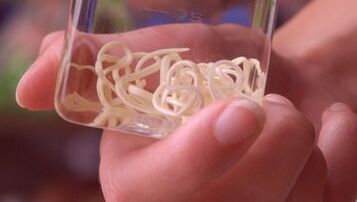
Many will be surprised if they find that a person is constantly living "not alone". On himself, as well as inside his body, microorganisms permanently exist, and without this mutually beneficial cohabitation, a person would be seriously ill and could not survive. So, on the surface of healthy skin there is a normal microflora that protects it from the reproduction of harmful microbes. In a woman's vagina, there are lactobacilli, or Dederlein sticks, which form a normal acidic environment. Finally, in the large intestine and stool of a healthy person, there are hundreds of billions of microorganisms involved in digesting food, producing vitamins, and protecting a person from disease.
But,With the exception of microbes, all other random organisms - protozoa, as well as worms - are parasites. . . Some start to multiply, "poisoning" our body. How to detect parasites in the human body?

This question is far from being in vain. Of course, if the doctor points the finger and says which parasites live in a certain person's body, then that patient will immediately go for tests. The same will happen if, for example, small worms are accidentally found in fresh feces. The question is clear: the helminthic invasion is obvious. It remains only to clarify the diagnosis and start treatment.
But parasites have learned to "keep their noses out", and often their existence in the body causes incomprehensible changes that the sick person does not associate with the presence of parasites at all. What are these symptoms? How to suspect, for example, chronic helminthiasis?
Common signs of parasites
The whole variety of parasitoses, ranging from accidental (transient) and ending with parasites that constantly live in the human body, are manifested by certain symptoms. They can be divided into two groups:
- specific(characteristic of a particular type of parasite), for example, puffiness and muscle pain with trichinosis, development of acute appendicitis by crawling in the appendix roundworm or excruciating itching in the perianal area in the presence of pinworms.
But it is good if there is such a symptom that accurately indicates the cause of the invasion (in medicine it is called pathognomonic). But how to determine the presence of parasites in the human body if there are no such direct signs?
To do this, check if there are other symptoms common to parasitosis - nonspecific.
- not specificsymptoms are signs that indicate poisoning of the body with wastes from worms and protozoa.
In turn, these signs most often appear in the form of two syndromes:
- an allergic reaction of the body to a parasite;
- intoxication or poisoning syndrome.
How to identify parasites in the human body and what symptoms do they cause?
The most common symptoms of parasitosis
- gradual, but steadily progressive decrease in body weight, not associated with chronic stress, increased level of physical activity;
- the onset of insomnia. It can be caused both by itching of the skin and by the release of toxins, for example during the migration of larvae. In this case, the person simply experiences a deterioration in his well-being in the evening and at night.
- the appearance of nausea and vomiting, sometimes due to an aversion to food;
- anorexia, or a marked decrease in appetite, up to and including its complete absence. For example, with giardiasis, children often have a morning aversion to food;
- there is a pronounced weakness, weakness, decrease in performance;
- daytime sleepiness appears;
- the temperature rises to subfebrile numbers (37, 1-37, 5);
- there is a cephalic syndrome: a headache appears that is not associated with physical and mental stress.

Allergic manifestations of helminthiasis can be different. Urticaria may occur, itchy skin without a cause may appear and disappear, allergic angioedema, bronchospasm may occur.
In that case,if you or your loved ones have any of the above symptoms, see a doctor. . .
Of course, this does not limit the range of symptoms, but they are the most common.
About laboratory signs
How to identify parasites in the human body using simple tests? For example, when studying the result of a general blood test, the following results indicate helminthic invasion:
- anemia, or a decrease in hemoglobin level and color index;
- eosinophilia. . . Normally, the number of eosinophils does not exceed 5%, and their number increases with parasitic diseases.
Of course, you do not have to pass all the tests in a row on your own, the doctor is better off what to prescribe in each specific case.
About accidental discoveries
Sometimes an accidental discovery can identify the presence of parasites in the human body. How can this happen?
- for example, with fluorography an unusual darkening of the lung field is found, which may turn out to be a parasitic cyst;
- During an MRI of the brain, it is also possible to detect single or multiple cysts, often without any symptoms.
In conclusion, it must be said thatafter the detection of these symptoms, a specific diagnosis is made: immune reactions are defined, feces are analyzed, if necessary, duodenal contents are taken. Of course, the history of life is very important. So, if a person rested the day before in hot countries in Asia and Africa and swam where it is not recommended, or used water of questionable quality or unwashed fruit, the presence of helminthic invasion is more than likely.

Likewise, if a child has similar symptoms after attending school, kindergarten and the parents are sure that the cause is not a state of stress due to the influence of an organized team, thenthere are more than enough reasons to visit an infectious disease pediatrician.
Treatment of identified helminthiasis is carried out in a special helminthological (parasitological) room, which usually exists in each regional center of the main hospital for infectious diseases.



























